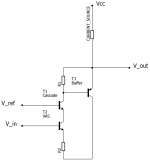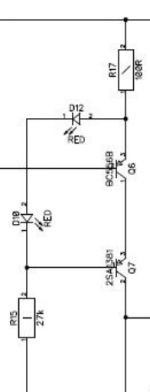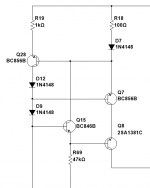Hello!
I want to build cascode VAS stage for my referrence amplifier projects since it is the lowest THD topology I know (I didn't say lowest of all, just in what I know).
My question is: What are requirements in the parameters for VAS transistors, cascode transistors, buffer transistors ( the last seem be not need to ask ) to achieve good result (minimize THD and optimize freq response, open-loop gain...)
) to achieve good result (minimize THD and optimize freq response, open-loop gain...)
I have read that: transistors for VAS stage should have low collector-base capacitance, but didn't mention any limit; and should have enough gain-bandwidth, but didn't mention the lower limit...
If what I have read are right, so why people use sth like MJE340/350 (in may design such as: Apex SR-xxx....) or 2N1711 (in JLH-1969) or 2N3439 (Leach as an example)? Those transistors seems have pretty high Cbc (except MJE340/350 which I can't find the mention about Cbc) and low Ft (like 2N1711 and MJE).
Those transistors seems have pretty high Cbc (except MJE340/350 which I can't find the mention about Cbc) and low Ft (like 2N1711 and MJE).
Sth like BF469/470 or 2SC3503/A1381 which have really low Cbc and high Ft seems much less popular (or which I have seen is just like a fish in the ocean?).
I want to build cascode VAS stage for my referrence amplifier projects since it is the lowest THD topology I know (I didn't say lowest of all, just in what I know).
My question is: What are requirements in the parameters for VAS transistors, cascode transistors, buffer transistors ( the last seem be not need to ask
I have read that: transistors for VAS stage should have low collector-base capacitance, but didn't mention any limit; and should have enough gain-bandwidth, but didn't mention the lower limit...
If what I have read are right, so why people use sth like MJE340/350 (in may design such as: Apex SR-xxx....) or 2N1711 (in JLH-1969) or 2N3439 (Leach as an example)?
Sth like BF469/470 or 2SC3503/A1381 which have really low Cbc and high Ft seems much less popular (or which I have seen is just like a fish in the ocean?).
Attachments
Medium power, high voltage (must be able to take the rail-rail voltage), capable of at least 100mA to be comfortable, 100MHz fT or better, and as low a Cob as possible.
Fairchild KSA1381/KSC3503 are the main ones I know of still in production. If you're OK with surface mount try Diodes Inc DZT5401/DZT5551. Unfortunately most of the best devices have disappeared thanks to CRT's becoming obsolete.
Fairchild KSA1381/KSC3503 are the main ones I know of still in production. If you're OK with surface mount try Diodes Inc DZT5401/DZT5551. Unfortunately most of the best devices have disappeared thanks to CRT's becoming obsolete.
I've been making some power amplifiers that are very similar in essence to the topology you show (but with a feed inductor instead of the current source). I've had very good luck using a DN2530 depletion MOSFET for the input device, running at about 10mA -- low noise, good linearity, very high input impedance, simple self bias using just a source resistor. Its input is sensitive to static and over-voltage, though, so I add some low leakage clamp diodes (two BC556B connected E-B-B-E, collectors open) from gate to source. Also it's drain to gate capacitance is VERY voltage sensitive, but the cascode arrangement takes care of that issue nicely.
If you want to make the distortion very low, add a PNP transistor to the MOSFET to form a FET-BJT Sziklai pair.
For the cascode transistor, I use BC556B. Actually, two of them in a darlington arrangement, as that assures all the input MOSFET's signal current passes through to the cascode's output (shows in the distortion a little). This transistor is only good to about 65V though. For higher voltages, I'd look at the KSA1381 too.
For the buffer, I add a mosfet stage (ZVP3310) before the BJT (which is KSA1381 and 2SC5200 in a Sziklai pair) to minimize loading on the cascode output. That probably depends on how much current the input and buffer are running.
Just a data point of a combination that seems to work really well, I'm sure there are lots of other choices. Hope this helps.
If you want to make the distortion very low, add a PNP transistor to the MOSFET to form a FET-BJT Sziklai pair.
For the cascode transistor, I use BC556B. Actually, two of them in a darlington arrangement, as that assures all the input MOSFET's signal current passes through to the cascode's output (shows in the distortion a little). This transistor is only good to about 65V though. For higher voltages, I'd look at the KSA1381 too.
For the buffer, I add a mosfet stage (ZVP3310) before the BJT (which is KSA1381 and 2SC5200 in a Sziklai pair) to minimize loading on the cascode output. That probably depends on how much current the input and buffer are running.
Just a data point of a combination that seems to work really well, I'm sure there are lots of other choices. Hope this helps.
Medium power, high voltage (must be able to take the rail-rail voltage), capable of at least 100mA to be comfortable, 100MHz fT or better, and as low a Cob as possible.
Fairchild KSA1381/KSC3503 are the main ones I know of still in production. If you're OK with surface mount try Diodes Inc DZT5401/DZT5551. Unfortunately most of the best devices have disappeared thanks to CRT's becoming obsolete.
"DZT5401"? So go for 2N5401 as through hole devices?
Thanks for very informative comment!I've been making some power amplifiers that are very similar in essence to the topology you show (but with a feed inductor instead of the current source). I've had very good luck using a DN2530 depletion MOSFET for the input device, running at about 10mA -- low noise, good linearity, very high input impedance, simple self bias using just a source resistor. Its input is sensitive to static and over-voltage, though, so I add some low leakage clamp diodes (two BC556B connected E-B-B-E, collectors open) from gate to source. Also it's drain to gate capacitance is VERY voltage sensitive, but the cascode arrangement takes care of that issue nicely.
If you want to make the distortion very low, add a PNP transistor to the MOSFET to form a FET-BJT Sziklai pair.
For the cascode transistor, I use BC556B. Actually, two of them in a darlington arrangement, as that assures all the input MOSFET's signal current passes through to the cascode's output (shows in the distortion a little). This transistor is only good to about 65V though. For higher voltages, I'd look at the KSA1381 too.
For the buffer, I add a mosfet stage (ZVP3310) before the BJT (which is KSA1381 and 2SC5200 in a Sziklai pair) to minimize loading on the cascode output. That probably depends on how much current the input and buffer are running.
Just a data point of a combination that seems to work really well, I'm sure there are lots of other choices. Hope this helps.
But in my place, I don't want to purchase any uncommon parts, since purchase parts seperately from American distributors will suck all of my small fund
And I don't love FET as much as BJT
The main reason MJE340/350 gets used so often is that they are easy to get. The BF469/BF470 are discontinued but their equivalent in surface mount are BF722/BF723
Only because they are easy to get?

Poor BF469/470
Only because they are easy to get?
Poor BF469/470
Hi,
Discontinued devices are very hard to get and if you can find one, the cost is way too high. IMO for VAS duty, a low cob high ft spec should be good enough. In this part of the world the TO-126 D669/B649 pair is a popular choice. If you want to look for the exotic type but very good device for VAS, grab an old CRT TV. Take those CRT video display drivers that can be found inside. Like this Sanyo device.
Attachments
Not a good VAS/TIS transistor.So If I have a transistor which have following parameters:
-Uce: 120V
-Ice: (cont.) 1A
-Pd: 0.8W
-Ft: min=50MHz
-Cbc: max=15pF
Can it be a VAS transistor?
It might make a good cascode transistor.
The cascode is very good at high frequencies relative to it's fT. So a low fT device will perform as well as needed (as a cascode) for a VAS/TIS that is apparently much faster judged by fT alone.
The VAS/TIS needs low power because it is protected by the cascode.
It needs adequate current, maybe 100mA to 200mA, not 1A
It needs speed, try fT>100MHz and needs to be biased to get close to this speed, so pick a VAS/TIS that gets near fT with a low Ic. There is no point in using an fT=300MHz but needs 150mA to get onto that part of the curve. look at 2sa1360 hits 100MHz @ 2mA and 2sa1381 hits 100MHz @ 5mA
Don't use TO-126 D669/B649. They make good driver transistors for the output stage.
Last edited:
"DZT5401"? So go for 2N5401 as through hole devices?
The DZT5401 is similar to a 2N5401 but it is in a SOT-223 case, which can dissipate more power than the TO-92 can. You can use the 2N5401/2N5551 at lower voltages though.
Not a good VAS/TIS transistor.
It might make a good cascode transistor.
The cascode is very good at high frequencies relative to it's fT. So a low fT device will perform as well as needed (as a cascode) for a VAS/TIS that is apparently much faster judged by fT alone.
The VAS/TIS needs low power because it is protected by the cascode.
It needs adequate current, maybe 100mA to 200mA, not 1A
It needs speed, try fT>100MHz and needs to be biased to get close to this speed, so pick a VAS/TIS that gets near fT with a low Ic. There is no point in using an fT=300MHz but needs 150mA to get onto that part of the curve. look at 2sa1360 hits 100MHz @ 2mA and 2sa1381 hits 100MHz @ 5mA
Don't use TO-126 D669/B649. They make good driver transistors for the output stage.
So I choose BC550C for VAS and BC639 for cascode.
The DZT5401 is similar to a 2N5401 but it is in a SOT-223 case, which can dissipate more power than the TO-92 can. You can use the 2N5401/2N5551 at lower voltages though.
Thanks, but I hate SMD parts because of my bad soldering speed
So I choose BC550C for VAS and BC639 for cascode.
Excellent choice.
Another good option is the KSC1845 - particularly if you can get the higher grades - since it has slightly better Cob than the BC550C.
Nikolai,
If the voltage between the positive and negative rails is less than 50Volts or so, then a BC550C will be OK, If you are using more than +/-25 Volts - which makes 50 Volts total, then a BC550C will be at risk of breaking down.
To answer your question:
- "Good" is a very vague concept.
- If you use MJE 340 / 350, the ampifier will work, and be very (very) robust, i.e. tolerant of abuse in the VAS area. My experience is however that the MJE340 / 350 exhibit some charge storage after clipping, which shows as clipped wave-forms "sticking" to the negative rail (with a low side VAS). This is not necessarily bad if you are after low cost and tough.
- If you want low distortion, and are OK with less common and possibly more expensive parts, then devices like the KSA1381 are technically much better. I choose these as I can afford them, and I am very concerned about the finer points of performance.
- The key parameters you need to respect are:
- VCE rating must be more that the TOTAL difference between V+, V-. ESSENTIAL
- Keep Capacitance Cb low, preferable < 10pf, but this is DESIRABLE.
- Keep cost - affordable.
To be honest, when I was young and could not afford to buy new stuff, I used ANYTHING. I used MJE340, TIP32/33 and all manner of odd stuff in this role. Guess what? It works, given the above.
Find your balance of $$$ and perfection, and have a lot of fun.
If the voltage between the positive and negative rails is less than 50Volts or so, then a BC550C will be OK, If you are using more than +/-25 Volts - which makes 50 Volts total, then a BC550C will be at risk of breaking down.
To answer your question:
- "Good" is a very vague concept.
- If you use MJE 340 / 350, the ampifier will work, and be very (very) robust, i.e. tolerant of abuse in the VAS area. My experience is however that the MJE340 / 350 exhibit some charge storage after clipping, which shows as clipped wave-forms "sticking" to the negative rail (with a low side VAS). This is not necessarily bad if you are after low cost and tough.
- If you want low distortion, and are OK with less common and possibly more expensive parts, then devices like the KSA1381 are technically much better. I choose these as I can afford them, and I am very concerned about the finer points of performance.
- The key parameters you need to respect are:
- VCE rating must be more that the TOTAL difference between V+, V-. ESSENTIAL
- Keep Capacitance Cb low, preferable < 10pf, but this is DESIRABLE.
- Keep cost - affordable.
To be honest, when I was young and could not afford to buy new stuff, I used ANYTHING. I used MJE340, TIP32/33 and all manner of odd stuff in this role. Guess what? It works, given the above.
Find your balance of $$$ and perfection, and have a lot of fun.
Last edited:
Nikolai,
If the voltage between the positive and negative rails is less than 50Volts or so, then a BC550C will be OK, If you are using more than +/-25 Volts - which makes 50 Volts total, then a BC550C will be at risk of breaking down.
Nikolai has just mentioned the cascoded configuration "BC550C for VAS and BC639 for cascode" - good one. In this case, BC550C voltage limits are not an issue any more
So If I have a transistor which have following parameters:
-Uce: 120V
-Ice: (cont.) 1A
-Pd: 0.8W
-Ft: min=50MHz
-Cbc: max=15pF
Can it be a VAS transistor?
Can you please tell what transistor it is?
Excellent choice.
Another good option is the KSC1845 - particularly if you can get the higher grades - since it has slightly better Cob than the BC550C.
Perhaps a misunderstanding but, what does "higher grade" means in the context of "slightly better Cob", ie. what qualities are we looking for in order to discerna a KSC1845 with "slightly better Cob" from the inferior types of KSC1845?
Last edited:
googlyone, an easy cure for that problem with the MJE340/MJE350 devices, is a Baker clamp diode. A 1N4148 will do in a pinch, though a BAV21 works better.
Totally agree, a fast recovery diode is ideal to reduce THD impact. It is evident in sim. The switching diode BAV21 works great, in sim and in my actual build. I have tested it in my old Blameless amp build.
googlyone, an easy cure for that problem with the MJE340/MJE350 devices, is a Baker clamp diode. A 1N4148 will do in a pinch, though a BAV21 works better.
Cascoded structure, like Hawksford's cascode (left picture) will show better results anyway, including rather clean clipping.
The right structure is my modification of the Hawksford's cascode - more complicated, but even more linear, and showing a perfect soft clipping (note, as shown - it's current-driven).
I normally use TO-126 device as a cascode transistor - more flexibility when working with higher (+/-50...75V) rails in terms of power dissipation.
3503/1381 are excellent, however MJE340/350 will also work well enough here.
Attachments
- Status
- This old topic is closed. If you want to reopen this topic, contact a moderator using the "Report Post" button.
- Home
- Amplifiers
- Solid State
- Requirements for cascode VAS transistors


